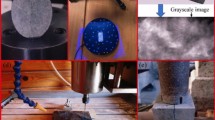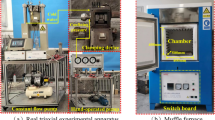Abstract
Rock deterioration is caused by freeze–thaw cycles, and this deterioration or loss of strength induces failure when the rock thaws. To accurately analyze freeze–thaw cycles, a proper method for evaluating the thermal conductivity of a fractured rock mass is needed. In this study, a simplified model of a fracture was derived from knowledge of actual fractures in rock masses, and the possible thermal resistance types of a fracture were analyzed. Then, according to the definition of thermal resistance, models were established for the normal and tangential thermal resistances of a fracture by considering the ice-water phase transition. Based on the thermal resistance models, a method for evaluating the equivalent thermal conductivity of a rock mass with a set of systematic fractures was established. The effect of the convective heat transfer of the water in the fractures was considered based on energy contributions. According to the superposition principle and the introduction of fracture parameters (strike angle, dip direction angle, and dip angle), the proposed method was extended to rock masses with multiple sets of fractures, and a sensitivity analysis was conducted. The thermal conductivity of a rock mass with connected fractures was more sensitive to the fracture parameters than that of a rock mass with intermittent fractures. Finally, the proposed method was verified by comparison with an experiment using a block of cement with artificial fissures under freezing conditions; the calculated temperature agreed well with the experimental results.
Highlights
-
A method for evaluating the thermal conductivity of a freezing rock mass is proposed.
-
The method considered the phase transition, convection and fracture parameters.
-
The convective heat transfer was considered based on energy contributions.
-
The thermal conductivity is more sensitive to the rock mass with connected fractures.




















Similar content being viewed by others

Notes
Equivalent thermal conductivity refers to the thermal conductivity, but it is the equivalent value of a continuum having the same volume as REV.
Fracture ratio refers to the ratio of the volume of fractures in RVE to the total volume of RVE.
Abbreviations
- REV:
-
Representative elementary volume
- ETC:
-
Equivalent thermal conductivity
- A :
-
Flow area
- A as :
-
Actual contact area
- A bs :
-
Nominal area
- N s :
-
Number of contact points
- Q :
-
Heat transmission rate
- R :
-
Thermal resistance
- R c :
-
Thermal conduction resistance
- R f :
-
Thermal convection resistance
- R fa :
-
Thermal convection resistance of air
- R fw :
-
Thermal convection resistance of water
- R m :
-
Thermal conduction resistance of the filling medium
- R n :
-
Normal thermal resistance of fractured media
- R r :
-
Thermal radiation resistance
- R s :
-
Thermal conduction resistance of the rock at the contact point
- R t :
-
Tangential thermal resistance of fractured media
- R tr :
-
Convective heat transfer resistance
- S :
-
Saturation
- T :
-
Temperature
- ΔT :
-
Temperature difference
- a :
-
Length of the fracture
- \(\overline{a}_{{\text{s}}}\) :
-
Average contact radius
- a s :
-
Actual contact radius
- b :
-
Center distance of the fractures
- b s :
-
Nominal radius
- \(\overline{c}_{{\text{s}}}\) :
-
Average interface contraction factor
- c s :
-
Interface contraction factor
- c a :
-
Specific heat of air
- c w :
-
Specific heat of water
- h :
-
Convective heat transfer coefficient
- k :
-
Thermal conductivity
- k a :
-
Thermal conductivity of air
- k fm :
-
Thermal conductivity of other solid fillers in the fracture
- k i :
-
Thermal conductivity of ice
- k m :
-
Normal equivalent thermal conductivity of the filling medium
- k mt :
-
Tangential equivalent thermal conductivity of the filling medium
- k n :
-
Normal equivalent thermal conductivity
- k t :
-
Tangential equivalent thermal conductivity
- k w :
-
Thermal conductivity of unfrozen water
- l :
-
Row spacing of the fractures
- l m :
-
Length of the fracture
- v a :
-
Velocity of air
- v w :
-
Velocity of water flow
- ΩT :
-
Temperature effect coefficient
- α :
-
Angle between the normal direction of the fracture and the horizontal coordinate axis
- β :
-
Dip angle of the fracture
- δ' :
-
Thickness of the single-layer plate
- δ :
-
Aperture of the fracture
- ζ :
-
Fracture ratio of the rock mass
- θ :
-
Volume content
- θ fm :
-
Content of solid fillers
- κ :
-
Boundary temperature factor
- ρ a :
-
Density of air
- ρ w :
-
Density of water
- φ :
-
Porosity
- χ :
-
Content of unfrozen water in the fracture fillings
- m :
-
Order number of dominant fractures
- w, i, fmt, r and a:
-
(Properties associated with) water, ice, solid fill, contact bodies and air
- g(c s) = (1 − ω)3/2 :
-
Contact influence function
- ω = A as /A bs :
-
Contact area ratio
- ψ = ωδ + (1 − ω)5/2 k m /k r :
-
Normal heat transfer factor
- ξ = aφSχ(1 − ω)ρ w c w ν w + k mt :
-
Tangential heat transfer factor
References
Albert K, Franz C, Koenigsdorff R et al (2017) Inverse estimation of rock thermal conductivity based on numerical microscale modeling from sandstone thin sections. Eng Geol 231:1–8
Bai B, He Y, Li X et al (2017) Experimental and analytical study of the overall heat transfer coefficient of water flowing through a single fracture in a granite core. Appl Therm Eng 116:79–90
Deprez M, Kock TD, Schutter GD et al (2020) A review on freeze-thaw action and weathering of rocks. Earth-Sci Rev 203:103143
Gibson RD (1976) The contact resistance for a semi-infinite cylinder in vacuum. Appl Energ 2:57–65
Heinze T (2021) Constraining the heat transfer coefficient of rock fractures. Renew Energ 177:433–447
Heinze T, Hamidi S, Galvan B (2017) A dynamic heat transfer coefficient between fractured rock and flowing fluid. Geothermics 65:10–16
Huang X, Zhu J, Li J et al (2016) Fluid friction and heat transfer through a single rough fracture in granitic rock under confining pressure. Int Commun Heat Mass 75(1):78–85
Incropera FP, DeWitt DP, Bergman TL et al (2006) Fundamentals of heat and mass transfer, 6th edn. Wiley, New York
Lai YM, Xu XT, Dong YH et al (2013) Present situation and prospect of mechanical research on frozen soils in China. Cold Reg Sci Technol 87:6–18
Lee GS, Jeon S, Lee CI (2004) Prediction of the temperature distribution around a food storage cavern, the analysis of three-dimensional heat transfer in a fractured rock mass. Int J Rock Mech Min 41(3):684–689
Li Z, Feng X, Zhang Y et al (2017) Experimental research on the convective heat transfer characteristics of distilled water in manmade smooth and rough rock fractures. Energy 133:206–218
Liu GH, Zhao ZH, Chen YD et al (2021) Comparison between typical numerical models for fluid flow and heat transfer through single rock fractures. Comput Geotech 138:104341
Matsuoka N (1990) Methanisms of rock breakdown by frost action: an experimental approach. Cold Reg Sci Technol 17(3):253–270
Nagaraju P, Roy S (2014) Effect of water saturation on rock thermal conductivity measurements. Tectonophysics 626:137–143
Park C, Synn JH, Shin HS et al (2004) Experimental study on the thermal characteristics of rock at low temperatures. Int J Rock Mech Min 41(3):1–6
Pei WS, Yu WB, Li SY et al (2013) A new method to model the thermal conductivity of soil–rock media in cold regions: an example from permafrost regions tunnel. Cold Reg Sci Technol 95:11–18
Shen YJ, Wang YZ, Zhao XD et al (2018) The influence of temperature and moisture content on sandstone thermal conductivity from a case using the artificial ground freezing(AGF) method. Cold Reg Sci Technol 155:149–160
Shu B, Wang YM, Zhu RJ et al (2022) Experimental study of the heat transfer characteristics of single geothermal fracture at different reservoir temperature and in situ stress conditions. Appl Therm Eng 207:118195
Sundberg J, Back PE, Ericsson LO et al (2009) Estimation of thermal conductivity and its spatial variability in igneous rocks from in situ density logging. Int J Rock Mech Min 46(6):1023–1028
Tan XJ, Chen WZ, Wu GJ et al (2013) Numerical simulations of heat transfer with ice–water phase change occurring in porous media and application to a cold-region tunnel. Tunn Undergr Sp Tech 38:170–179
Acknowledgements
We express our gratitude to the anonymous reviewers for their constructive comments and suggestions. This research was supported by the Talent-Technology Foundation (No. RC1804) and Special Funds of the Natural Science Foundation (No. ZR18017) of Xi’an University of Architecture and Technology, the Natural Science Basic Research Program of Shaanxi (Nos. 2019JQ-756, 2022JM-190), the Special Scientific Research Project of Shaanxi Education Department (No. 19JK0452), the China Postdoctoral Science Foundation (No. 2019M663648), and the Open Fund of State Key Laboratory of Road Engineering Safety and Health in Cold and High-Altitude Regions (No. YGY2020KYPT-03).
Author information
Authors and Affiliations
Corresponding author
Additional information
Publisher's Note
Springer Nature remains neutral with regard to jurisdictional claims in published maps and institutional affiliations.
Rights and permissions
Springer Nature or its licensor holds exclusive rights to this article under a publishing agreement with the author(s) or other rightsholder(s); author self-archiving of the accepted manuscript version of this article is solely governed by the terms of such publishing agreement and applicable law.
About this article
Cite this article
Liu, N., Li, N., Li, G. et al. Method for Evaluating the Equivalent Thermal Conductivity of a Freezing Rock Mass Containing Systematic Fractures. Rock Mech Rock Eng 55, 7333–7355 (2022). https://doi.org/10.1007/s00603-022-03038-9
Received:
Accepted:
Published:
Issue Date:
DOI: https://doi.org/10.1007/s00603-022-03038-9



